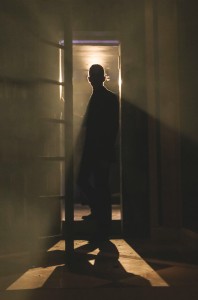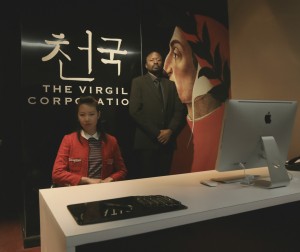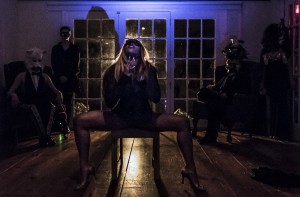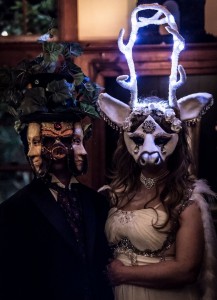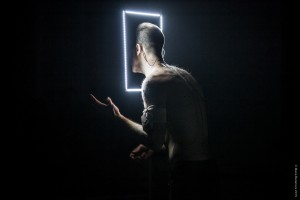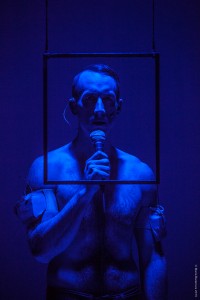During the Holocaust, the atrocities of the Nazi regime forced countless Jewish families and individuals into hiding. Though they were not interned in concentration camps, these stowaways were subjected to another, silent, reign of terror—in which every creak and cough could result in discovery, detainment, and almost certain death. Thus, the scene is set for The Hidden Ones, an immersive theater production that brings audiences into the secret hiding place of two families at the end of World War II
The Girl Who Handcuffed Houdini
Harry Houdini is arguably the most famous magician of all time, but the circumstances around his death remain suspiciously murky. Did he truly die suddenly of appendicitis, or were there more malevolent forces afoot? Cynthia von Buhler’s The Girl Who Handcuffed Houdini combines murder mystery, film noir, and comic book genres to create a genuinely fun immersive theater experience wherein audiences can explore the mysteries surrounding Houdini’s death.
KPOP
Ars Nova’s KPOP begins with a chorus of glittering young Korean pop performers belting the lyrics “the future’s standing right in front of you.” Indeed, the purported mission of the play’s fictional management enterprise, JTM Entertainment, is to bring K-Pop to American audiences, and the production delivers K-Pop-styled numbers in droves.
Pool Play 2.0
Plenty of New Yorkers are familiar with plays performed in parks, bars, or museums. But a play in a pool? This is Not a Theatre Company’s Pool Play 2.0 is just that, taking place in an indoor swimming pool at Waterside Plaza Swim and Health Club (it should be noted that This is Not a Theatre Company is known for its experimental approaches to performance space). Each audience member receives a poncho upon entering the warm, chlorine-infused pool space, and is invited to pick any bath mat as a seat; at the pool’s edge, the audience's feet dangle into the water. The uniqueness of Pool Play 2.0 does not end with its nontraditional performance space, however. The play's text, its staging, and the committed actors collaborate to provide a fun yet thought-provoking treatment of something nearly everyone has experienced: a day at the pool.
The Strangest
The Fourth Street Theater is currently unrecognizable, as the theater company known as Semiotic Root has transformed the space into an intimate storytelling café—the sort found in North Africa. A patchwork of Persian carpets covers every inch of the floor, and hanging lanterns cast a warm glow across the carved wooden tables and plush floor cushions. The scent of strong coffee wafts through the air, and audience members are invited to help themselves to a cup. The setting is for playwright Betty Shamieh’s The Strangest, an absurdist murder mystery inspired by the unnamed Arab killed in Albert Camus’ classic novel, The Stranger, which is an emblem of mid-20th-century French existentialism.
Home/Sick
The Weather Underground Organization, also know as the Weathermen, was a grassroots collective of white radical leftists who subscribed to a militant, anti-capitalist ideology. Splintering off from a larger organization called Students for Democratic Society (SDS) in the late 1960s, the Weather Underground believed in violence as a form of protest. Home/Sick is The Assembly’s theatrical reimagining of the Weather Underground’s founding, development, and eventual disbandment. Written collectively by members of The Assembly, Home/Sick is a dynamic and thorough piece of devised theater that highlights the complex philosophies, political struggles, and practical idiosyncrasies behind the Weather Underground’s bygone revolution.
Rule of 7x7
With a whole host of traditional plays and musicals available to choose from, it is sometimes refreshing when theater artists in New York City experiment with form. Creator and producer Brett Epstein’s Rule of 7x7 is just that: an experiment in playwriting wherein seven playwrights each declare a “rule” that must be incorporated into each play. These rules range from a word, a line, or a specific stage direction. To intensify the process, the artists involved have just one month to mount these short plays from conception to performance.
Othello: The Remix
As one of Shakespeare’s most famed tragedies, Othello has seen quite a number of adaptations over the years. The artistic duo Q Brothers take their stab at adapting this timeless play with Othello: The Remix, which discards Shakespeare’s original iambic pentameter in favor of modern rhyme set to rap music. In the spirit of Hamilton and other sung-through and hip-hop-infused musicals, Othello: The Remix is 80 minutes of fast-paced lyricism—spun live by cast member DJ Supernova and with hardly a breath in between. While there are a few questionable production choices, the massive amount of creative energy and impressive talent on display in Othello: The Remix make it hard to resist.
A Classic Comedy Conquest
Playwright Oliver Goldsmith found fame with his play She Stoops to Conquer in 1773, despite his rather unfashionable social reputation among London’s upper crust. Indeed, Goldsmith made it his life’s work to go against the grain, and She Stoops to Conquer exemplifies his disdain for Sentimental Comedy—a genre that was en vogue in the first part of the 18th century. Those saccharine works featured one-dimensional characters whose apotheosis was meant to instill what Sentimental playwright Richard Steele haughtily deemed “a joy too exquisite for laughter.”

Goldsmith, on the other hand, was a champion of hearty laughter, which this play—when produced well—can stir up in droves. Compared to Sentimental characters, Goldsmith’s characters are imperfect, and therein likable. The Actors Company Theatre (TACT) is staging a slightly imperfect (and therein quite likable) production of Goldsmith’s important play, directed and adapted by Scott Alan Evans. The moments when this production shines most are when it is faithful to Goldsmith’s unique genre of “laughing comedy,” aimed to elicit belly laughs with physical ridiculousness and silly twists of plot.
She Stoops to Conquer presents a bouquet of delightful characters—two eligible ingénues, a couple of bachelors from the city, and a pair of meddling parents—all of whom are subject to the playful deceits of the puckish Tony Lumpkin (Richard Thieriot). The action takes place at Mr. and Mrs. Hardcastle’s estate in the English countryside. Their daughter Kate (Mairin Lee) and their ward, Constance Neville (Justine Salata), are excited to receive two handsome young suitors (Charles Marlow and George Hastings, played by Jeremy Beck and Tony Roach) at the estate that evening.
Tony, who also happens to be Kate’s illegitimate brother, foils the plan when he intercepts the suitors at the village pub. Wanting to free himself of his mutually undesired betrothal to Constance, Tony concocts some of his signature meddling. Bringing the suitors to the estate, Tony leads them to believe that they are staying a night at an inn—and that the elder Hardcastles are actually innkeepers. This creates room for Kate, disguised as a barmaid, to woo the painfully shy Marlow, and for her cousin Constance to pursue her true love Hastings.
Overall, the cast seems to enjoy themselves in this genre. Thieriot as Tony absolutely sparkles with his mix of conniving wit and lowbrow buffoonery. As his bumbling parents, Cynthia Darlow and John Rothman are adorably befuddled by their son’s antics. Things really get good after intermission, in which Tony sends his enraged mother and Constance on a 40-mile carriage ride to nowhere, and Mr. Hardcastle finally snaps after being treated like the help in his own home. The two sets of young lovers deserve even more spice, however, especially in light of their comic counterparts; perhaps that could be created with more emphasis on physical humor rather than delivery of language.
One distinct aspect of this production is its intermittent puncturing of the fourth wall. Evans’s direction leans heavily on this device, employing a considerable amount of direct audience interaction and unmasking of the usual theatrical dressings. For example, there is no backdrop to hide the actors as they await their entrances. Instead, they are visibly seated in two rows of chairs on either side of the stage, which is a raised platform. Admittedly, Goldsmith's original script contains plenty of asides—monologues that characters deliver directly to the audience—but by stripping the stage bare, Evans’s adaptation carries the meta-theater several steps further. The bits of audience interaction between scenes undermine the actors’ comic choices and interrupt the flow and style of the play. All in all, however, this nontraditional choice does not sink the production, which provides both a fun night at the theater as well as an opportunity to experience one of England’s most important and beloved plays.
TACT’s She Stoops to Conquer plays at the Clurman Theatre at Theatre Row (410 West 42nd Street between Ninth and Tenth avenues) until Nov. 5. Tickets are available online here or by calling the TACT Member Hotline at (212) 560-2184 or (212) 947-8844.
A Paradise for Paranoia
You are locked inside the small lobby of a corporate office building with 10 other strangers. An ominous voice on an intercom informs your group that you have one hour to escape. The lights go out. A screen flickers on, flashing random surreal images quicker than your brain can process. A human eye; a girl in a forest; a Romantic painting; an architectural spiral. Everyone panics.
This might sound like a nightmare, but it's actually the beginning of Paradiso Chapter 1, a self-described immersive theatrical escape room experience located in Korea Town. Created by theatrical innovator Michael Counts, Paradiso tries to set itself apart from other New York City escape rooms by incorporating several rooms of immersive theater, live actors, and "existential themes." Despite these claims, however, Paradiso does not escape the genre of escape rooms, which is limited by design.
Originating in the early 2000s, escape rooms have gained popularity in many cities across the world, especially in Asia and the U.S. In New York alone, there are dozens of escape rooms to choose from. The concept is simple, but the design can be very complicated: groups of participants are put inside a room or series of rooms and must solve a gauntlet of puzzles within a set time in order to "escape." Many of these rooms have themes. Paradiso Chapter 1 seems to evoke corporate corruption similar to dystopian film and TV shows like Mr. Robot or V for Vendetta, with scattered references to Dante's Divine Comedy.
The Paradiso experience begins days in advance with a series of cryptic text instructions sent to your personal cell phone. A few hours before, you are instructed to meet at an obscure karaoke bar in K-Town. While this messaging system seemed to work for some participants, for one technical reason or another, several others did not receive correspondence. A set of email instructions advice participants to surrender all of their belongings to storage before the experience, but no such check was mandated (only offered to participants who wanted to shed their bags). This meant that, for better or for worse, our group relied on our cell phones throughout the experience—for illumination, notes, or recording clues or images.
During the experience, actors appear to help or hinder your quest to escape. Sarah Jun, Claire Sanderson, Joe Laureiro, and Brian Alford all manage to develop interesting characters within the confines of the escape room format. It is unclear exactly what is at stake, but it seems as if Virgil Corporation is trying to cover up some secrets hidden within their commercial empire. It is left ambiguous whether any of the characters are sympathetic to Virgil Corporation, or whether they are sincerely trying to help you escape. With such a talented cast at hand, Paradiso might consider developing a clearer storyline and incorporating each actor further into the fabric of the experience, perhaps to develop a storyline and to offer insight into the show's supposed existential themes. Instead, the actors felt more like fancy props, limited to (with the exception of Jun) garbled utterances about clues.
Escape rooms, by nature, are different every time. One may or may not escape, depending on the speed at which their group finds and interprets clues correctly. Paradiso claims to incorporate immersive theater techniques, but do not expect the same level of detail as the exquisitely designed sets of companies like Punchdrunk or Third Rail. These immersive companies take precise care to make sure that every object within the interactive set tells a story. The objects in Paradiso seem more haphazard. Additionally, many immersive theater productions, such as Tony & Tina's Wedding, allow participants to talk to the characters and piece together a narrative through their interactions. However, do not expect to interact meaningfully with the characters as one might in local immersive productions such as Speakeasy Dollhouse or The Grand Paradise Hotel.
Escape rooms are not for everyone, but if you enjoy high-pressure gaming environments, definitely attend Paradiso: Chapter 1. Be aware that the pace is fast, the energy is high, and the rooms can become very hot. If immersive and interactive theater is more your thing, consider skipping this one. Our group was unsuccessful in escaping, and Alford's character booted us to the curb as quickly as Jun's had swept us in. Despite failing, it was a unique experience, and will definitely get your adrenaline going.
The open-ended run of Paradiso: Chapter 1 plays Wednesday–Friday from 6–9:30 p.m., Saturday from 2–9.30 p.m., and Sunday from 2–8:30 p.m., with audiences entering every half hour. Paradiso: Chapter 1 takes place at a secret location in Korea Town that is not unveiled until audiences arrive at a designated meeting point shared when their tickets are booked. Tickets start at $45 and are available via www.paradisoescape.com. Advance booking is required.
A Heartsong for Hades
Anaïs Mitchell’s Hadestown, a concept album turned folk opera, adapts the myth of Orpheus by infusing it with American folk and New Orleans jazz music. Now playing at New York Theatre Workshop, Hadestown follows Orpheus (Damon Daunno) to hell and back again in pursuit of his young lover, Eurydice (Nabiyah Be), who has been lured there by the lord of the underworld, Hades (Patrick Page). Being a “folk opera,” the production is almost entirely sung-through, and Rachel Chavkin’s direction carries one song fluidly into the next. Like its classical source, Hadestown is alternatively gorgeous and dark, and the heartfelt commitment of the cast and musical ensemble brings the myth’s paradoxically sad beauty into full bloom.
As an energetic balance of hope and sadness, Hadestown finds light in the darkness and vice versa. The production’s casting reflects this balance: the naiveté of Be’s Eurydice and Daunno’s Orpheus contrasts starkly with the underworldly knowingness of Amber Gray’s Persephone and Chris Sullivan’s Hermes. Sullivan’s portrayal of his character is particularly complicated, as an enlisted messenger for the underworld with a soft heart for the young lovers. The Fates (played by Jessie Shelton, Shaina Taub, and Lulu Fall) are similarly uncommitted in their alliances, singing at times of great love and at others of shattering despair. As the brooding, unrelenting Hades, Page’s reverberating bass vocals figuratively open the doors of hell itself. In voice and movement, this hugely talented ensemble strikes near-perfect harmony in Act I. Act II contains major strengths, including some of the show’s most tear-jerking moments, but overall it lacks the simpatico energy of Act I.
Based on Mitchell’s celebrated folk album, music is the absolute center of Hadestown. Indeed, at times this music-forward production feels more like a highly-produced concert than a play—which works well with such a polished songbook. Michael Chorney and Todd Sickafoose’s co-arrangements and Liam Robinson’s musical direction sonically transform the space into a concert-in-the-round, immersing audiences with powerful voices and instrumentals.
Chavkin puts the space, reconfigured to stadium seating, to great use with entrances and exits from all angles and levels. Visually, Bradley King’s lighting synergizes with the music, especially in Act I’s penultimate “Wait for Me.” In this number, the Fates swing hanging wire lamps to and fro, visually embodying the show’s undulating emotional landscape between hope and uncertainty.
Adapting ancient Greek myths is nothing new for off-Broadway directors, but Mitchell and Chavkin’s Hadestown feels particularly fresh right now. In the “Wedding Song” Eurydice asks her new lover Orpheus how their young, penniless relationship will ever survive with “times being what they are—dark and getting darker all the time.” Eurydice’s ambiguity resonates in a time when the American middle class is dwindling and senseless acts of violence continue to erupt here and abroad. Later in Act I, Hades delivers a timely diatribe in the song “Why We Build the Wall,” echoing the latent xenophobia drummed up by the current election campaign’s fear-based politicking.
At the same time, amid this darkness, the pure love between Eurydice and Orpheus shines through—even Hades and Persephone's fraught relationship contains a hidden softness. Indeed, the sweet vulnerabilities embedded in the music and performances of Hadestown convey the very joys and hardships that make being human so painfully beautiful.
Hadestown runs through July 31 at New York Theatre Workshop (79 E. 4th Street between Bowery and 2nd Avenue.) No late seating. Tickets are available here or by calling 212-460-5475.
On Your Feet for NoFit
Circus has long been a beloved popular entertainment in the United States (and in many other places around the globe). From P.T. Barnum's early acts to New York's very own Big Apple Circus, a day at the big top brings up many different associations: balancing elephants, high-flying trapeze artists, the smell of peanuts and popcorn in the air. NoFit State Circus, a collective of circus performers from Wales, presents its own modern take on this classic performance form with its latest touring show, Bianco, pitching its tent just outside St. Ann’s Warehouse in Brooklyn. .
Gather, Ye Illuminati Hopefuls
In 1972, wealthy Parisian socialite Marie-Hélène de Rothschild threw an elaborately occult Illuminati Ball at her family’s chateau. Guests of honor included Salvador Dali and Audrey Hepburn, and the coveted invitations requested “black tie, long dresses, & Surrealist heads.” Today, nearly 50 years later, immersive maven Cynthia von Buhler reimagines the Illuminati Ball at her estate, and her guest list could include you. Known for her previous immersive productions Speakeasy Dollhouse and Midnight Frolic, von Buhler is at it again with her most exclusive experience yet.
Like the original Rothschild event, von Buhler takes care to construct an atmosphere of selectivity and secrecy beginning at the participant’s initial point of entry. Potential guests must apply for attendance and, once chosen, are delivered precise instructions on what to wear and where to meet. Von Buhler then shuttles participants to her estate via a limousine fitted with blackout curtains. For even the most seasoned immersive theatergoers, the secretive applications, invitations, and strict instructions are enough to drum up some excitement and anticipation about the evening to come.
While the individual talents of the interspersed performances provide ample diversions, certain aspects of The Illuminati Ball disrupt its immersive flow. A bit of shuffling amongst organizers while boarding and riding the limousine partially dispels the illusion that participants are actually being considered for candidacy in the Illuminati. While it is no small feat to conceal the complicated logistics involved in such an elaborate immersive experience, the success of the production relies on this very concealment. Furthermore, Illuminati Ball seems only partially committed to its narrative. Some performers, such as the honey-voiced Eden Atencio as Kamadhenu and von Buhler herself as the heiress of the estate, seem more committed to interacting candidly with audience members. Other characters seem more concerned with advancing the plot, which crescendos confusingly in the middle of dessert. Transitions between dinner, group scenes, and individual interactions feel a bit like herding cats.
Casting the production’s somewhat disjointed storyline aside, Illuminati Ball provides something else far more special in its discarding of the fourth wall. The ability to eat with and interact with the actors and the fellow attendees is the production’s greatest joy.
The conviviality is amplified by the evening’s spread of small plates and cocktails, the quality of which far surpasses any usual dinner theater fare. The dinner, lovingly prepared and artfully plated by chef Erin Orr, consists of delightful colors and textures. The real sorcerer behind this production is mixologist Bootleg Greg, whose (virtually unlimited) flavorful concoctions fuel the evening’s revelry. For better or for worse, the drama of Illuminati’s muddled storyline is eclipsed by the evening’s more sensual pleasures of food, drink, socialization, music, and dance. In any case, the most pleasant surprise of The Illuminati Ball is its unique ability to facilitate connections among audience members, actors, and performers as they carouse in the moonlight.
The Illuminati Ball: An Immersive Excursion by Cynthia von Buhler runs bi-monthly on Saturday evenings through Aug. 20 (specific dates here) at 6 p.m. at a secret location one hour outside of Manhattan. Apply for attendance here.
Do You Know You Are Nowhere?
With a flash of bright light and a bone-rattling buzz, Youarenowhere begins with an assault on the senses. The show's creator and star, Andrew Schneider, enters the performance space seeming as disoriented as his audience. He tries to find his feet in reality, but this is no small task, since a taut thread of existential anxiety may be the only thing holding Youarenowhere together. Will this hypermediated anxiety destroy Schneider? Will it destroy us all? Where are we, anyway? The answer, of course, is Youarenowhere. Schneider's intermedial mashup avoids letting the audience get comfortable in any genre, morphing from an existential diatribe into a TED Talk on metaphysics. From there, it becomes a magic show and an experimental dance piece. The accelerated and indeterminate nature of Youarenowhere could not succeed without its seamless choreography of sound, lighting and tech cues. This design is expertly executed by the show's crew: technical director Karl Franklin Allen, light/video supervisor Daniel Jackson, sound supervisor Bobby McElver and stage manager Alessandra Calabi. Consider the work of these technicians a remedy for theatergoers who haven't had their breath taken away in a long time.
The hyper-technological and multi-genre performance art style Schneider draws from is not entirely new, and he certainly cites his sources. Indeed, the citational nature of network technology—with its wikis and file sharing and retweeting—creates many opportunities for reference within performance. Considering the breakneck pace at which most of Youarenowhere progresses, it's impossible to catch all the references or to pursue each philosophical abyss opened up by Schneider in his tweaky, nervous manner. Schneider splices songs by Rihanna and Robyn in with classical music and an especially touching rendition of Ricky Nelson's "Lonesome Town," awash in cobalt blue.
For followers of The Wooster Group, the influence of Schneider's seven years of membership in that company will be readily apparent. In one sequence, a video projection of a young Schneider (at a filmed audition) ghosts the present-day Schneider. He recites a monologue with his past self with hardly a flaw. The "hardly" should be emphasized here since it is the ever-diminishing distinction between man and machine that inspires the technological and choreographic design of this moment. There is more philosophical exploration to be done on this subject, however, in the script of the play.
Though the sound, lighting and tech design of Youarenowhere formally performs the ever-present tension between (and fusion of) technology and humanity, this is precisely where the written script falls short. There exists a lacuna between Schneider's buggy, technologically mediated physicality and the words he actually says. Schneider lectures us on metaphysics and love, but he doesn't offer much tangible insight into the effects of technology and the Internet on the human experiences of love, loss and addiction. Youarenowhere's only missing piece is its reluctance to verbally process the very difficult and very daunting possibility that we are becoming machines and that machines are becoming us. Again, Schneider physically performs this tension, but his monologues tend to skirt the issue.
Schneider muses that "we exist in each other's realities. But maybe not in the way that we think that we do." When theater succeeds in calling upon us to question the very nature of our existence, it is worth seeing. It seems prudent to forewarn sensitive audiences of the bright light and loud sound in Youarenowhere. Furthermore, people with a history of anxiety or panic attacks should take note of the show's intense pacing and content. That being said, Youarenowhere could be extremely cathartic for the anxious, the lovelorn and the grieving. In provoking both awe and intense existential questioning, Youarenowhere (somehow) simultaneously satisfies one's inner child and cynic. It should not be missed.
Youarenowhere runs until April 3 at 3LD Art & Technology Center (80 Greenwich St. between Edgar and Rector Sts.) in the Financial District. Tickets range from $15-$35 and are available here or by calling 3LD Art & Technology Center at 212-645-0374.















